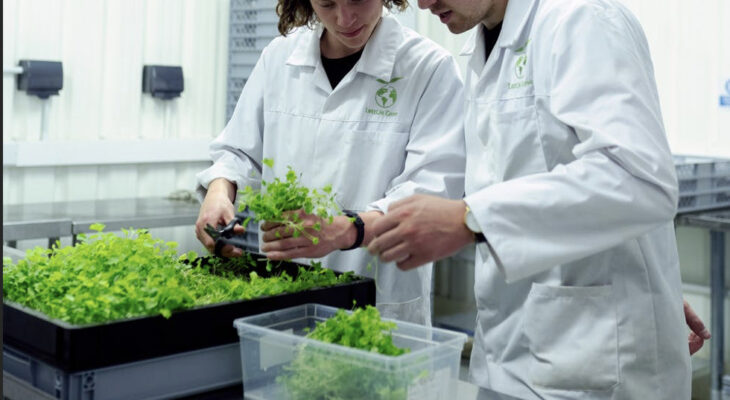While artificial intelligence (AI) appeared to be science fiction until recently, various organizations around the world are now studying ways to incorporate this technology into daily life. AI operates by analyzing enormous amounts of data, interpreting patterns in the data, and converting these interpretations into actions similar to those of a human. Scientists have used it to build self-driving vehicles and chess-playing computers, but it has also been applied to agriculture. AI can inspire more effective farming methods to tackle global warming, but only if its growth is tightly regulated.
Climate change continues to pose a threat to every area of our life, including food production. According to a study from Wageningen University, climate change will actually diminish soil moisture in locations around the equator while leaving northern countries largely unaffected. Lower crop yields are glaring proof of the impact of these altered growth conditions on our food production.
The reduction of food production has a particularly negative impact on underdeveloped countries. Climate change results in a loss of 35 trillion consumable food calories every year, putting poorer countries at a disadvantage because they cannot afford to import food. As a result, food insecurity is on the rise. Rising sea levels only exacerbate the problem. Sea levels are anticipated to increase by one meter by 2100, posing a problem for coastal growers whose crops cannot live in overly saline water.
Agriculture is both a victim and a driver of global warming. Agriculture is a part of a vicious cycle in which farming causes global warming. This creates a vicious cycle where global warming causes agricultural production to suffer. Deforestation occurs as a result of removing the flora and fauna in land that has been set aside for agriculture, which contributes to 40% of worldwide methane generation. As a result, to combat climate change, we must practice reforestation.
How do we achieve this, and what is the path towards efficient, environmentally conscious farming?
This is where artificial intelligence (AI) comes into play. Farmers utilize AI for precision agriculture, which allows them to monitor crop moisture, soil composition, and temperature in growing areas. This allows them to boost yields by learning how to care for their crops and calculating the optimal amount of water or fertilizer to use.
The use of AI in agriculture has given rise to apps that give farmers advice on water management, crop rotation, timely harvesting, optimal planting, and pest attacks. We can forecast meteorological conditions, control nutrition, and assess crop sustainability using machine learning algorithms and photos obtained by satellites and drones.
Precision farming is a method of increasing crop yields by utilizing data inputs in precise amounts. Farmers can acquire a tailored plan for their farms using AI software. They can then meet the needs of our current and future worlds using IoT and AI-driven solutions, such as greater food production and profitability, without depleting our natural resources.
Soil is one of the most significant components of the health and development of a plant. The soil’s nutrition determines the quality of the crop. As a result of deforestation, soil quality deteriorates with time, making it difficult for farmers to determine which soil is ideal for which crop. With the help of AI, farmers are now able to monitor soil and crop quality in real-time.
Furthermore, by allowing humans to grow food in urban places, this technology may reduce deforestation. One Israeli tech startup used AI algorithms to produce perfect light and water conditions to grow crops in a container small enough to be housed inside a home. The technology could prove especially useful in Latin American and Caribbean countries, where most of the population lives in cities. Furthermore, growing food in pre-existing metropolitan areas means that humanity may become less reliant on deforestation to meet their food needs.
Additionally, AI can assist in identifying and protecting carbon sinks or forest regions that absorb carbon dioxide from the atmosphere. If these trees are not cleared, more carbon dioxide will be released into the sky. Furthermore, artificial intelligence is being created to detect and target weeds in a field with the proper quantity of herbicide, removing the need for farmers to disperse chemicals across entire fields and contaminate the environment. Some countries have already begun to use AI in their agriculture practices.
Outside of agriculture, AI can be utilized to reduce global warming. The technology may track how energy-efficient buildings are and keep an eye on urban heat islands. Urban heat islands are formed when heat is absorbed by urban building materials such as concrete and asphalt, leading cities to become hotter than their surroundings. For this reason, people rely more heavily on air conditioning throughout the day to stay cool, resulting in increased greenhouse gas emissions from the energy consumed. Providing information on the locations of these islands could assist legislators in deciding what policies to implement to minimize emissions and encourage more efficient and environmentally-conscious city planning.
Over the years, pollution levels have risen dramatically, and climatic conditions have become increasingly unpredictable. Farmers have found it challenging to decide the best time to sow seeds due to climate change, and this is where AI comes into play once more. It is simple to acquire knowledge into how weather, seasonal sunlight, wind speed, and rain will affect agricultural planting cycles using artificial intelligence. Farmers will be able to examine and plan when to plant their seeds using weather predictions. A use-case for AI, in this case, would be IBM weather forecast. In a weather interruption, IBM weather forecast sends out notifications and offers integrated solutions to maximize crop yields, limit environmental impact, and save money.
As mentioned previously, crop yield can be improved using real-time sensor data and visual analytics data from drones, thanks to AI and machine learning in agriculture. Drones can provide real-time video surveillance and analysis of agricultural growth patterns. On the other hand, smart sensors can provide information on moisture, fertilizer, and natural nutrient levels. Additionally, drones are viable for obtaining data on how various fertilizers, irrigation patterns, and pesticide treatments improve crop yields.
Along with drones, companies using artificial intelligence are developing robots that can perform a variety of farming tasks. These robots will be taught to manage the spread of weeds and to collect crops. They’ll also be taught how to pick and bag crops. Rather than relying fully on humans for labor, the goal is to automate such manual operations and complete them at a considerably faster rate with more significant volumes.
While we have discussed the benefits of AI, we must also address the challenges.
When used incorrectly, AI can contribute to global warming. Data storage and processing centers that provide digital services like entertainment and cloud computing now account for 2% of global greenhouse gas emissions. This is the aviation industry’s overall contribution to pollution. Due to the vast quantity of data that AI must analyze, training a single AI system emits five times the emissions that an average car would generate during its lifetime, adding to the already significant effect of computer technology on the environment.
Given these problems, we cannot use AI as the only response to climate change. Adaptive technologies can help alleviate the effects of climate change, but more comprehensive steps are needed to ensure global food security in the face of rising temperatures. Before investing in AI on a larger scale, global leaders must evaluate the possible costs, the role of legal institutions, and the environmental effects of data processing.
When used wisely, the multiple benefits that AI offers truly outweigh the negatives. Of course, both individuals and companies need to evaluate whether they can afford to invest in an efficient AI system that actually protects the environment.
In the hopes of helping the underdogs succeed in positively impacting their community, Aquaponics AI powers the heroes of next-gen production with technology and research to improve their farms. Aquaponics AI can also connect farmers with system designers and thought leaders in the industry. The team has connected with the industry’s thought leaders and innovators to work and solve food insecurity by collaborating and expanding the practice of aquaponics globally.
For more information about Aquaponics AI, click here.





